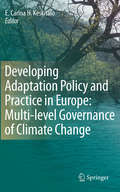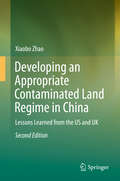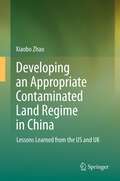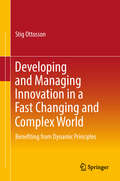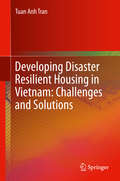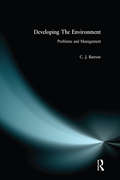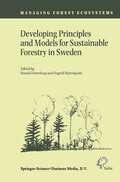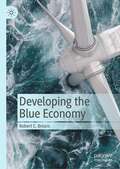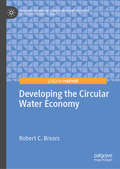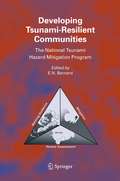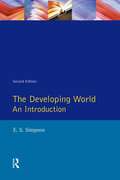- Table View
- List View
Deutschlands Norden: vom Erdaltertum zur Gegenwart
by Margot Böse Jürgen Ehlers Frank LehmkuhlDieses Buch erklärt die faszinierende Entstehung der Landschaft im Norden Deutschlands, so wie sie sich heute zeigt. Dabei spannen die Autoren einen Bogen von der Jungsteinzeit bis hin zur Moderne. Im ersten Teil des Buches beschreiben die Autoren detailliert welche Prozesse die Landschaft vor der Eiszeit geformt haben. Im zweiten Teil des Buches gehen sie auf die verschiedenen rezenten Natur- und Landschaftsräume ein, in die sich der Norden Deutschlands gliedert und erklären deren Entstehungsgeschichte. Am Ende des Buches zeigen die Autoren auf, wie der Mensch die Landschaft in den letzten 7500 Jahren geprägt hat, um abschließend einen Überblick über die aktuellen Maßnahmen zum Schutz der Landschaft zu geben.
Deutschlands Norden: vom Erdaltertum zur Gegenwart
by Margot Böse Jürgen Ehlers Frank LehmkuhlDieses Sachbuch erklärt die faszinierende Entstehung der heutigen Landschaft im Norden Deutschlands. Das Ziel ist es, in einer integrativen Betrachtungsweise geowissenschaftliche, archäologische und ökologische Forschungsergebnisse zusammen zu führen und vielfältige Veränderungen des Naturraumes durch den Menschen darzustellen. Für die neue Auflage wurden daher etliche Kapitel grundlegend überarbeitet und ergänzt und es wurden neue, spannende Exkurse eingefügt. Im ersten Teil beschreiben die Autoren die Geologie des Untergrundes und die später durch den Menschen genutzten Rohstoffe, vornehmlich Salze und Kohle. Auch die Klimageschichte spielt eine wichtige Rolle bei der Landschaftsentwicklung, daher werden dem Leser einige gängige Forschungsmethoden für die eiszeitlichen und nacheiszeitlichen Klimaveränderungen vorgestellt. Im nächsten Teil des Buches wird auf die verschiedenen rezenten Natur- und Landschaftsräume mit ihren spezifischen Oberflächenformen eingegangen: die unterschiedlichen Küsten von Nordsee und Ostsee, die ehemals vergletscherten Moränenlandschaften der quartären Vereisungen, die Mittelgebirge Harz und Eifel und die großen Flusssysteme. Am Ende des Buches zeigen die Autoren auf, wie der Mensch die Landschaft in den letzten 7.500 Jahren genutzt und damit umgestaltet hat. Abschließend wird ein Überblick über die aktuellen Maßnahmen zum Schutz der Landschaft und zum Erhalt der ökologischen Vielfalt gegeben. Das reich bebilderte, anschauliche und zum Stöbern einladende Buch ist eine erweiterte und ergänzte Auflage und liefert mit seinen Schwerpunkten: · Einen tiefen Einblick in die spannende Geschichte der Landschaft im Norden Deutschlands. · Eine fundierte Beschreibung der einzelnen Landschaftsräume und deren Entstehung. · Aktuelle Forschung zur Prägung und immer weiter zunehmenden Veränderung der Umwelt durch den Menschen seit Beginn der Jungsteinzeit. Als Leser möchten wir Studierende, Lehrende und aber auch gerade interessierte Laien gewinnen, die sich für Norddeutschland als Natur- und Kulturraum interessieren. Daher ist das Buch sprachlich so abgefasst, dass es einen breiten Leserkreis anspricht.
Deutschlands Süden - vom Erdmittelalter zur Gegenwart
by Joachim Eberle Bernhard Eitel Wolf Dieter Blümel Peter WittmannSüddeutschland gehört zu den abwechslungsreichsten Landschaften der Erde. Kaum eine andere Region bietet auf so engem Gebiet eine vergleichbare Vielfalt an Naturräumen: Grundgebirgs- und Schichtstufenlandschaften, die gewaltige Bruchzone des Oberrheingrabens und alpine Hochgebirgsregionen sind ebenso zu finden wie von Vulkanismus, Gletschern und Meteoriteneinschlägen geprägte Landschaften. Süddeutschland erlebte in den letzten 140 Millionen Jahren tropische, subtropische und arktische Klimaphasen, deren Spuren bis heute in Teilen der Landschaft zu erkennen sind. Begeben Sie sich auf eine faszinierende Zeitreise durch Süddeutschland und verfolgen - die Frühphase der Landformung unter tropischen Klimaverhältnissen - die Entwicklung von Oberrheingraben und Alpenvorland - die Entstehung der Schichtstufenlandschaften - die Flussgeschichte von Donau und Rhein - die „heiße Phase“ mit Vulkanismus und Meteoriteneinschlägen - die kaltzeitliche Überformung der Landschaft - die Entstehung der von Menschenhand gestalteten Landformen - die Zukunft der süddeutschen Landschaft Die Verfasser stellen die Landschaftsgeschichte Süddeutschlands allgemein verständlich für einen breiten Leserkreis dar. Sie entwerfen zu den einzelnen Zeitphasen ein virtuelles Bild Süddeutschlands. Vergleiche - und vierfarbige Fotos - mit heutigen Landschaften außerhalb Europas ermöglichen es dem Leser überdies, eine bessere Vorstellung des einstigen Erscheinungsbildes von Süddeutschland zu entwickeln. In Exkursen werden interessante regionale Informationen vermittelt und auch Methoden, wie man zu den dargestellten Erkenntnissen gelangt. In der vorliegenden 2. Auflage wird ein ausführlicher Blick auf die Zukunft der süddeutschen Landschaft geworfen. Das mit zahlreichen vierfarbigen Grafiken, detaillierten Blockbildern und anschaulichen Fotos aufwändig gestalte Sachbuch will zum besseren Verständnis unseres heutigen Lebens- und Wirtschaftsraumes beitragen. Die ökologischen und ökonomischen Potenziale Süddeutschlands lassen sich ohne eine Berücksichtigung der Landschaftsgeschichte nicht erklären. .
Deutschlands Süden - vom Erdmittelalter zur Gegenwart
by Joachim Eberle Bernhard Eitel Wolf Dieter Blümel Peter Wittmann Bettina AllgaierSüddeutschland gehört zu den abwechslungsreichsten Landschaften der Erde. Kaum eine andere Region bietet auf so engem Gebiet eine vergleichbare Vielfalt an Naturräumen: Grundgebirgs- und Schichtstufenlandschaften, die gewaltige Bruchzone des Oberrheingrabens und alpine Hochgebirgsregionen sind ebenso zu finden wie von Vulkanismus, Gletschern und Meteoriteneinschlägen geprägte Landschaften. Süddeutschland erlebte in den letzten 140 Millionen Jahren tropische, subtropische und arktische Klimaphasen, deren Spuren bis heute in Teilen der Landschaft zu erkennen sind. Begeben Sie sich auf eine faszinierende Zeitreise durch Süddeutschland und verfolgen - die Frühphase der Landformung unter tropischen Klimaverhältnissen - die Entwicklung von Oberrheingraben und Alpenvorland - die Entstehung der Schichtstufenlandschaften - die Flussgeschichte von Donau und Rhein - die „heiße Phase“ mit Vulkanismus und Meteoriteneinschlägen - die kaltzeitliche Überformung der Landschaft - die Entstehung der von Menschenhand gestalteten Landformen - die Zukunft der süddeutschen Landschaft Die Verfasser stellen die Landschaftsgeschichte Süddeutschlands allgemein verständlich für einen breiten Leserkreis dar. Sie entwerfen zu den einzelnen Zeitphasen ein virtuelles Bild Süddeutschlands. Vergleiche - und vierfarbige Fotos - mit heutigen Landschaften außerhalb Europas ermöglichen es dem Leser überdies, eine bessere Vorstellung des einstigen Erscheinungsbildes von Süddeutschland zu entwickeln. In Exkursen werden interessante regionale Informationen vermittelt und auch Methoden, wie man zu den dargestellten Erkenntnissen gelangt. In der vorliegenden 2. Auflage wird ein ausführlicher Blick auf die Zukunft der süddeutschen Landschaft geworfen. Das mit zahlreichen vierfarbigen Grafiken, detaillierten Blockbildern und anschaulichen Fotos aufwändig gestalte Sachbuch will zum besseren Verständnis unseres heutigen Lebens- und Wirtschaftsraumes beitragen. Die ökologischen und ökonomischen Potenziale Süddeutschlands lassen sich ohne eine Berücksichtigung der Landschaftsgeschichte nicht erklären. .
Developing a Successful Subsidiary Strategy: A Step-by-Step Toolkit for Managers
by Paul LyonsMost books on business strategy approach the subject from a corporate perspective – covering topics such as the vision for the business, the marketplace, competition, differentiation etc. However, the reality is that most managers work in sub-units or subsidiaries of the business and they are not involved in corporate strategy formulation. Their strategic concerns are with the positioning and future trajectory of their own units within the complex internal ecosystem in which they exist. If these units are to survive and grow, the middle managers responsible for them must plan their future, maximize their value-add, and compete for resources within the internal market of their corporations. Such internal markets are becoming increasingly volatile due to general economic conditions, but also given the questioning of globalization and increasing corporate concerns about the frailties of international supply chains as brought into sharp focus by the Covid-19 crisis and the war in Ukraine. This book provides practical perspectives for these business unit managers, and a step-by-step toolkit that can be used by management teams to develop a successful subsidiary strategy that acknowledges these challenges while maximizing their contribution to corporate objectives. It is based on the authors 30 years of experience as an executive in a complex multinational (IBM) organization, supplemented by academic study at Masters and PhD level. The material covered has been verified through workshops over a 3-year period with the senior leadership teams of 25 multinational subsidiaries operating from Ireland.
Developing a Successful Subsidiary Strategy: A Step-by-Step Toolkit for Managers
by Paul LyonsMost books on business strategy approach the subject from a corporate perspective – covering topics such as the vision for the business, the marketplace, competition, differentiation etc. However, the reality is that most managers work in sub-units or subsidiaries of the business and they are not involved in corporate strategy formulation. Their strategic concerns are with the positioning and future trajectory of their own units within the complex internal ecosystem in which they exist. If these units are to survive and grow, the middle managers responsible for them must plan their future, maximize their value-add, and compete for resources within the internal market of their corporations. Such internal markets are becoming increasingly volatile due to general economic conditions, but also given the questioning of globalization and increasing corporate concerns about the frailties of international supply chains as brought into sharp focus by the Covid-19 crisis and the war in Ukraine. This book provides practical perspectives for these business unit managers, and a step-by-step toolkit that can be used by management teams to develop a successful subsidiary strategy that acknowledges these challenges while maximizing their contribution to corporate objectives. It is based on the authors 30 years of experience as an executive in a complex multinational (IBM) organization, supplemented by academic study at Masters and PhD level. The material covered has been verified through workshops over a 3-year period with the senior leadership teams of 25 multinational subsidiaries operating from Ireland.
Developing Adaptation Policy and Practice in Europe: Multi-level Governance Of Climate Change
by E. Carina H. Carina H. KeskitaloMitigation will not be sufficient for us to avoid climate change and we will need to adapt to its consequences. This book targets the development of adaptation policy in European countries with different relations between central and regional/local government.
Developing an Appropriate Contaminated Land Regime in China: Lessons Learned from the US and UK
by Xiaobo ZhaoThis book explores the complex package of mechanisms used to identify, record, manage and remediate contaminated land, including the system for allocating liabilities that has been set up by China’s contaminated land law and accompanying administrative decrees and environmental standards. Statutory control of soil or land contamination is a comparatively new phenomenon for Chinese lawmakers and researchers. After more than ten years of preparation, China recently adopted its first nationwide contaminated land law—the Law of the People’s Republic of China on the Prevention and Control of Soil Contamination, which entered into effect in the beginning of 2019. The law deals exclusively with risk management in connection with soil contamination, and the remediation of contaminated land. This book analyzes various facets of how China is managing the risks associated with soil contamination and remediating contaminated sites by means of legislation. Chapters 1 and 2 reveal the current extent of the soil contamination problem in China and the initial policy responses of the country’s central government. In turn, Chapters 3 and 4 address the regulatory frameworks and the latest contaminated land legislation at both the local and national level. Lastly, Chapters 5 through 9 offer concrete recommendations, based on lessons learned in the US and UK, for reforming contaminated land management in China. Overall, the book covers the past, present and future of contaminated land management in China, making it of interest to environmental policymakers, administrators, academics, lawyers and engineers engaged in soil or environmental protection. Further, it offers a source of reliable information for those who want to learn more about China’s environmental legislation and contaminated land management policy.
Developing an Appropriate Contaminated Land Regime in China: Lessons Learned from the US and UK
by Xiaobo ZhaoLike all industrialized countries, China has encountered increasing problems with land contamination in recent years. Abandoned mining and manufacturing sites and obsolete industrial complexes, while also creating new polluting industrial enterprises, represent impending environmental threats. More importantly, a number of social and economic problems have developed and must be dealt with, in some cases urgently. Contaminated land laws and regulations have been established and have evolved in the US and UK and many other jurisdictions over the past few decades. These regimes have substantially influenced the relevant legislation in the context of numerous Asian and European countries and will inevitably benefit similar legislative efforts in China. This book is the first monograph that focuses on how China can learn from the US and UK with respect to contaminated land legislation and comprehensively illustrates how contaminated land law could be created in China. It will be of interest to academics and practitioners in environmental law in China, as well as the US and UK.
Developing and Managing Innovation in a Fast Changing and Complex World: Benefiting from Dynamic Principles
by Stig OttossonThis book provides essential insights into how to rapidly and safely develop new sustainable products, no matter whether it is in the private sector, the public sector or the non-profit sector, and regardless of the specific national or business culture.The principles discussed were distilled from experiences and insights gained in numerous practical innovation endeavors, and from insider action research in connection with ongoing development, change management, and innovation projects in various areas and branches of the business world and non-commercial sector.In short, the practical work and research has revealed that, regardless of the specific product and/or business to be developed, clear advantages can be gained by using dynamic or agile methods based on modern theories. These advantages include: reduced risk of failure, shorter time to market, less money and effort spent, better outcome solutions, etc. than when classical methods are used. Accordingly, the book also highlights the differences between the classical/traditional and dynamic mindset and approaches. It offers suggestions on how to think, organize, lead, and act in order to excel in an increasingly complex and non-linear world. The more you can assimilate the theories, principles and methods – and integrate them in the culture you operate in – the greater the benefits will be for you and your organization.
Developing CDM Projects in the Western Balkans: Legal and Technical Issues Compared
by Massimiliano MontiniDeveloping CDM Projects in the Western Balkans: Legal and Technical Issues Compared, arises from the professional practical experience gained by an interdisciplinary team of legal and technical experts acting in the framework of the environmental bilateral cooperation performed by the Italian Ministry for the Environment, Land and Sea in the Western Balkan countries, through the "Task Force for Central and Eastern Europe". The added value of the book consists in the fact that it jointly presents the real professional experience gained by a multi sectoral team of lawyers, economists, engineers and other technical experts, working in synergy with a shared vision. This volume will be useful not only to those specifically interested in the Western Balkan area, but represents a broader example of lessons learned in the development of CDM projects. Therefore, it may have a broad market among Government officials and legal-economic-technical professionals dealing with climate change issues as well as academics developing scientific research in this field.
Developing Disaster Resilient Housing in Vietnam: Challenges and Solutions
by Tuan Anh TranThis book provides a comprehensive understanding on disaster resilient housing within the Vietnam context particularly and the developing world generally. The book has identified the root causes of housing vulnerability, restrictions to safe housing development, concepts of disaster resilient housing, key issues/factors implementers and building designers need to consider, and ways of achieving resilient housing outcomes in actual design projects.The design and development of disaster resilient housing has been framed into three main themes:(i) community consultation, (ii) the role of built-environment professionals and (iii) design responses for resilience. To achieve these themes, there is a variety of contextual and intervening conditions that need to be addressed and met to provide an enabling environment for promoting disaster resilient housing. These three themes are among the most arguable issues in recent debates and discussions, academically and practically, regarding disaster risk reduction and safe housing development. In addition, this book also provides the evidence-based design framework for disaster resilient housing upon which design ideas and solutions for safe and resilient housing can be generated and shaped.
Developing Earthly Attachments in the Anthropocene (Routledge Research in the Anthropocene)
by Edward H. HuijbensThis book explores the development and significance of an Earth-oriented progressive approach to fostering global wellbeing and inclusive societies in an era of climate change and uncertainty. Developing Earthly Attachments in the Anthropocene examines the ways in which the Earth has become a source of political, social, and cultural theory in times of global climate change. The book explains how the Earth contributes to the creation of a regenerative culture, drawing examples from the Netherlands and Iceland. These examples offer understandings of how legacies of non-respectful exploitative practices culminating in the rapid post-war growth of global consumption have resulted in impacts on the ecosystem, highlighting the challenges of living with planet Earth. The book familiarizes readers with the implied agencies of the Earth which become evident in our reliance on the carbon economy – a factor of modern-day globalized capitalism responsible for global environmental change and emergency. It also suggests ways to inspire and develop new ways of spatial sense making for those seeking earthly attachments. Offering novel theoretical and practical insights for politically active people, this book will appeal to those involved in local and national policy making processes. It will also be of interest to academics and students of geography, political science, and environmental sciences.
Developing Earthly Attachments in the Anthropocene (Routledge Research in the Anthropocene)
by Edward H. HuijbensThis book explores the development and significance of an Earth-oriented progressive approach to fostering global wellbeing and inclusive societies in an era of climate change and uncertainty. Developing Earthly Attachments in the Anthropocene examines the ways in which the Earth has become a source of political, social, and cultural theory in times of global climate change. The book explains how the Earth contributes to the creation of a regenerative culture, drawing examples from the Netherlands and Iceland. These examples offer understandings of how legacies of non-respectful exploitative practices culminating in the rapid post-war growth of global consumption have resulted in impacts on the ecosystem, highlighting the challenges of living with planet Earth. The book familiarizes readers with the implied agencies of the Earth which become evident in our reliance on the carbon economy – a factor of modern-day globalized capitalism responsible for global environmental change and emergency. It also suggests ways to inspire and develop new ways of spatial sense making for those seeking earthly attachments. Offering novel theoretical and practical insights for politically active people, this book will appeal to those involved in local and national policy making processes. It will also be of interest to academics and students of geography, political science, and environmental sciences.
Developing The Environment: Problems & Management
by C. J. BarrowThis book presents a comprehensive overview of global environmental problems - past, present and future - examining their roots and implications and suggesting, where possible, ways in which they might be mitigated or avoided by careful management.
Developing The Environment: Problems & Management
by C J BarrowThis book presents a comprehensive overview of global environmental problems - past, present and future - examining their roots and implications and suggesting, where possible, ways in which they might be mitigated or avoided by careful management.
Developing Frontier Cities: Global Perspectives — Regional Contexts (GeoJournal Library #52)
by Harvey Lithwick Yehuda GradusThe Unique Nature of Frontier Cities and their Development Challenge Harvey Lithwick and Yehuda Grad us The advent of government downsizing, and globalization has led to enormous com petitive pressures as well as the opening of new opportunities. How cities in remote frontier areas might cope with what for them might appear to be a devastating challenge is the subject of this book. Our concern is with frontier cities in particular. In our earlier study, Frontiers in Regional Development (Rowman and Littlefield, 1996), we examined the distinction between frontiers and peripheries. The terms are often used interchangeably, but we believe that in fact, both in scholarly works and in popular usage, very different connotations are conveyed by these concepts. Frontiers evoke a strong positive image, of sparsely settled territories, offering challenges, adventure, unspoiled natural land scapes, and a different, and for many an attractive life style. Frontiers are lands of opportunity. Peripheries conjure up negative images, of inaccessibility, inadequate services and political and economic marginality. They are places to escape from, rather than frontiers, which is were people escape to. Peripheries are places of and for losers.
Developing Geographical Indications in the South: The Southern African Experience
by Cerkia Bramley, Estelle Biénabe and Johann KirstenThis book contributes to the literature on Geographical Indications (GIs) by providing key theoretical reflections from a five-year review process on the potential of GIs for agri-food products in Southern Africa. The contributors reflect on diverse GI processes and dynamics which operate at the local, national and international levels, thus enriching the understanding of GI dynamics and of the variety of policy options available for GI protection in Southern countries. Following a discussion of the legal framework and governance of national GI schemes in Southern countries, the book emphasizes the main dimensions underlying the development of GIs and their potential for enhancing sustainable rural development and market access in particular. This provides the structure for the chapters that build on the different experiences of Southern African industries that have embarked on GI strategies. The book includes chapters on designing an appropriate legal framework and governance system for the development of GIs in Southern countries.
Developing Principles and Models for Sustainable Forestry in Sweden (Managing Forest Ecosystems #5)
by H. Sverdrup Ingrid StjernquistIn this book is summarized those management principles that should be valid in areas where forests continuously are used for production, where biodiversity aspects are important as well as economy and productivity, and where demands on soil status and water quality are set. Especially the very long-term aspects are emphasized, and it is shown how system model thinking is used to reach the goals. Biogeochemical aspects are put forward as they are very important in areas on poor bedrock with acid soils. Forest vitality and stress on trees are treated, as well as the importance of wildlife and their effects of browsing. The balance between social and recreational demands from the society and the economical needs of the landowner is of great concern. Experiences from a special area in South Sweden are presented.
Developing the Blue Economy
by Robert C. BrearsTraditionally, the ocean economy is viewed solely as a mechanism for economic growth. In this business-as-usual approach, large-scale industrial economies have developed the ocean economy through the exploitation of maritime and marine resources, often without consideration of how those activities impact the future health or productivity of those same resources. This has led to aquatic ecosystems being viewed and treated as limitless resources; the marine environment becoming a dumping ground for waste; overfishing diminishing fishing stocks; ocean habitats being degraded from coastal developments; sea-level rise impacting coastal communities and infrastructure; increasing ocean acidification; and the marginalisation of poor coastal communities.Recognising the failings of the traditional ocean economy, there is a transition underway around the world towards the Blue Economy. This concept moves beyond the business-as-usual approach with economic development and ocean health complementary to one another. In the Blue Economy, the environmental risks of and ecological degradation from economic activity are mitigated or significantly reduced. Therefore, economic activity is in balance with the long-term capacity of the ocean ecosystems to support this activity and remain healthy and resilient. This book will provide an overview of the various technologies used to promote cross-sectoral and multi-scalar collaboration, facilitate the integrated management of sectors and resources, foster partnerships between governments and industry, encourage R&D in new technologies in resource use and management, and scale-up innovative financing mechanisms in the development of a Blue Economy. Also, the book will contain in-depth case studies that illustrate how locations, of differing climates, lifestyles and income levels, have implemented technologies to facilitate the development of the Blue Economy.Developing the Blue Economy will provide an accessible resource for practitioners and researchers working in the field on the various innovative technologies being implemented around the world to create a Blue Economy.
Developing the Circular Water Economy (Palgrave Studies in Climate Resilient Societies)
by Robert C. BrearsThis book presents new research on policy innovations that promote the development of the circular water economy. In contrast to the linear economy, the circular water economy promotes the reduction of water consumption, reuse of water, and recovery of resources from wastewater to not only increase resilience to climate change but also to reduce greenhouse gas emissions resulting from the provision of water and wastewater-related services. Providing a series of in-depth case studies of important locations in differing climates around the globe that have implemented a variety of policy innovations to develop the circular water economy, this book is a valuable resource for water and resource conservation managers, policymakers, international companies and organisations interested in the circular economy, environmental NGOs, researchers, as well as graduate and undergraduate students. · Systematically reviews policy innovations to develop the circular water economy· Illustrates how leading locations from around the world have developed the circular water economy to increase resilience to climate change while reducing emissions · Provides ‘best practices’ for other locations around the world aiming to implement the circular water economy
Developing the Underdeveloped Countries: Geographical Readings (pdf) (Geographical Readings Ser.)
by Alan B. MountjoyDeveloping Tsunami-Resilient Communities: The National Tsunami Hazard Mitigation Program
by E. N. BernardAs the world grieves over the catastrophic loss of humanity from the 26 December 2004 tsunami, we must resolve to learn from nature’s lessons. This issue provides a framework and a set of tools to develop communities that are resilient to tsunami. This collection of papers represents a starting point on our new journey toward a safer world. The history of tsunami hazard mitigation tracks well with the history of destructive tsunamis in the United States. Following the 1946 Alaska g- erated tsunami that killed 173 people in Hawaii, the Paci?c Tsunami Warning Center was established in Hawaii by a predecessor agency to the National Oceanic and Atmospheric Administration (NOAA). Following the 1960 Chilean tsunami that killed 1,000 people in Chile, 61 in Hawaii, and 199 in Japan, the United States formed the Joint Tsunami Research E?ort (JTRE) and sta?ed the International Tsunami Information Center (ITIC) in Hawaii. JTRE was formed to conduct research on tsunamis while ITIC, sponsored by the United Nations, was formed to coordinate tsunami warning e?orts of the Paci?c Countries. Many research and mitigation e?orts were focused on the distant tsunami problem. Following the 1964 Alaskan t- nami that killed 117 in Alaska, 11 in California, and 4 in Oregon, the U. S. was confronted with the local tsunami problem. In response, the U. S. established the Alaska Tsunami Warning Center in Palmer, Alaska. In 1992, a Ms 7.
Developing World, The: An Introduction
by E. S. SimpsonAddresses the issues faced by developing nations in attempting to secure sustainable economic development.
Developing World, The: An Introduction
by E. S. SimpsonAddresses the issues faced by developing nations in attempting to secure sustainable economic development.





